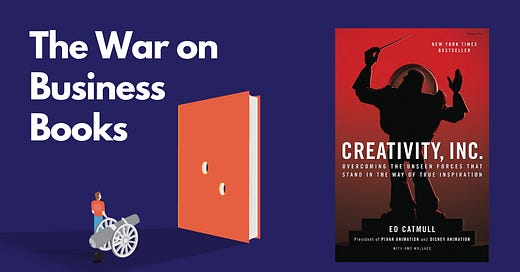:::Why are you receiving this? You’re friends with Cam Houser. This is where I share atypical stories of creativity, entrepreneurship, growth, and the ups and downs of Actionworks:::
🎟Welcome Dhruvaj, Adriana, Deja, Shelley, Keiran, E, A, Yuejun, Glenn, James, and Mandy 🎟
Greetings, rulebreakers!
In this newsletter:
DIY video update: hello videos and new edition of the workshop
Pixar’s approach to introducing wild ideas
Newsletters > pitch decks
Learn Video: Hello Videos and Workshop Update
One of the exercises we went over in the DIY Video Session was the “hello video,” where you send a 10-20 second greeting to someone. The point of this exercise is to get more familiar being on camera and understanding the basics of audio, lighting, and framing.
I’ve received videos from y’all every few days since the workshop. They’re amazing. So here’s a reminder: I’m happy to receive hello videos from the rest of you as well. I won’t share them publicly and will give you a few lines of feedback. My email is in my signature or message me on twitter.
And we’re definitely going to run another version of the session. Announcement coming soon.
How to introduce a wild idea, Pixar-style

:::The War on Business Books is the section where I share interesting ideas from business books and other media:::
Ed Catmull founded Pixar Animation Studios.
In Creativity, Inc, he writes about how his animation teams would get creatively blocked and resistant to change. And often, they simply weren’t thinking big enough.
So how did he handle this?
Ed describes a tactic that he and a colleague figured out to get teams on board for big and bold ideas. Something that worked to gauge how the team might receive bold new directions.
Their approach?
They introduce an idea as if it was never going to happen.
“So I try to trick them. I’ll say, ‘This would be a big change if we were really going to do it, but just as a thought exercise, what if …’ Or, ‘I’m not actually suggesting this, but go with me for a minute …’
If people anticipate the production pressures, they’ll close the door to new ideas—so you have to pretend you’re not actually going to do anything, we’re just talking, just playing around. Then if you hit upon some new idea that clearly works, people are excited about it and are happier to act on the change.”
Introducing big changes in this way sidestepped the initial resistance that crops up whenever people hear new ideas. If resistance arose immediately and never faltered, he would know it was probably not the right time for that particular idea.
But often, this approach gave a challenging idea room to breathe. And that room to breathe would allow teams to embrace scary but necessary changes.
Newsletters > Pitch Decks
This year, I’m testing a new spin on my entrepreneurship class at the University of Texas. I’m asking my students to start a newsletter before they build pitch decks.
From some upcoming writing on the subject:
Accountants have spreadsheets.
Painters have paint brushes.
And entrepreneurs have pitch decks.
Pitch decks are the tool they use to show insights, rally others, and demonstrate learning. But most young entrepreneurs at the earliest part of the process have a different problem: they don't yet have the insights and learning to convey in the first place.
In this essay, I'm going to argue that we've had it wrong all along. The pitch deck isn't the right tool for early stage entrepreneurs. Nor is a canvas.
Starting out, the personal newsletter is a better tool to build insights because it facilitates learning in public, emphasizes process, and allows one-to-many interactions.
What do you think? Agree? Disagree?
See you in gallery view,
Cam

Web: actionworks.co
Twitter: @cahouser
Have a question? Ask it here
For professional grade virtual courses, workshops, and coaching, email cam@actionworks.co
Slow motion bird footage from my balcony to your inbox:




